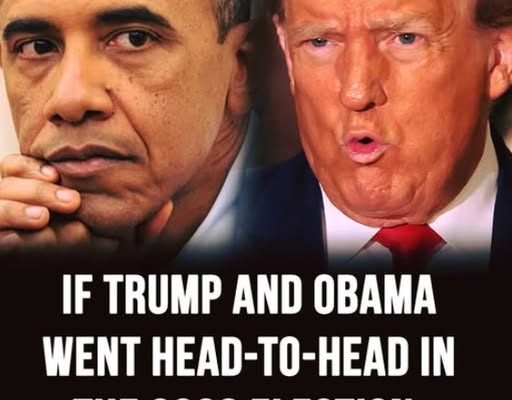If Barack Obama and Donald Trump ever went head-to-head in a 2028 presidential election, the world would stop to watch. The matchup would pit two of the most polarizing yet charismatic figures in modern American history against each other—one representing a message of unity and hope, the other of disruption and populist rebellion. While it’s impossible under current constitutional law, imagining this political showdown offers a fascinating look at the forces shaping American democracy.
First, the legal barrier. The U.S. Constitution’s Twenty-Second Amendment clearly states that no person can be elected President more than twice. Barack Obama, who served from 2009 to 2017, has already reached that limit. Donald Trump, having served one term and possibly seeking another in 2028, would also face restrictions if he won reelection before that year. So, in reality, neither man could legitimately run again without a constitutional amendment. Yet for the sake of analysis, let’s suspend that rule and explore how such a contest might unfold in the court of public opinion.
Polls give us a glimpse into how Americans might respond. Several surveys conducted in recent years have asked voters to imagine this exact scenario. A Newsweek report on polling data from Overton Insights found that if Obama and Trump could run again, Obama would lead by roughly six percentage points—53 percent to 47 percent. Another poll by J.L. Partners for the Daily Mail showed Obama leading 52 percent to 41 percent. These numbers reveal something striking: years after leaving office, Obama remains one of the most popular political figures in the United States, while Trump continues to divide voters almost evenly.
Obama’s strength lies in his broad appeal across multiple demographics. He maintains overwhelming support among Black and Hispanic voters, two groups that were key to his victories in 2008 and 2012. He also performs well with independents, suburban voters, and younger Americans. Obama’s time in office, for many, symbolizes stability and optimism, a contrast to the political turmoil and polarization that have characterized much of the post-2016 landscape. Nostalgia plays a powerful role in politics, and Obama benefits from it immensely. Many voters look back on his presidency as a calmer, more diplomatic era, particularly in foreign affairs and national tone.
Trump, on the other hand, continues to command unmatched loyalty among his base. His supporters admire his bluntness, outsider persona, and perceived willingness to fight the political establishment. Even after years of controversy, Trump’s populist message—centered on nationalism, border security, economic protectionism, and cultural conservatism—resonates strongly with millions of Americans. In rural communities, small-town America, and the conservative South and Midwest, Trump’s “America First” ideology still holds deep appeal. His ability to mobilize voters who feel alienated by Washington’s political elite cannot be underestimated. In a close election, turnout from this group could make or break the result.
If the two faced off in debates, their contrasting communication styles would define the campaign. Obama, articulate and measured, would focus on vision, unity, and evidence-based arguments. Trump, fiery and unpredictable, would seek to dominate the stage through emotional energy, humor, and aggression. Their exchanges would likely be the most watched debates in American history. Obama would attack Trump on divisiveness and governance style, while Trump would accuse Obama of weakness and globalism. Each would frame the other as the embodiment of everything wrong with American politics—Obama as elitist and disconnected, Trump as dangerous and chaotic.
In terms of campaign strategy, Obama’s team would rely on coalition-building, digital outreach, and targeted messaging in swing states like Pennsylvania, Michigan, Wisconsin, Arizona, and Georgia. These states helped him win twice, and they would remain essential battlegrounds. Obama would emphasize middle-class growth, healthcare, and restoring America’s reputation abroad. He’d likely focus on optimism and competence—contrasting his calm leadership style with Trump’s often turbulent record.
Trump’s strategy would be based on mobilization and resentment politics. He would campaign as the champion of those who feel “left behind” by globalization, cultural change, and perceived elite hypocrisy. His message would hammer themes of border control, crime, inflation, and patriotism. Trump would likely hold massive rallies to energize his base and use social media to dominate the conversation. He’d frame the election as a battle for the “real America” against political correctness and media manipulation.
The outcome would depend heavily on voter turnout and generational dynamics. Younger voters overwhelmingly lean Democratic, and Obama’s charisma still resonates with them, even after his presidency. Older, rural, and evangelical voters, however, lean toward Trump. The urban-rural divide would be sharper than ever. The suburbs—particularly white, college-educated suburbanites who drifted away from Trump after 2016—could be decisive. Obama would likely reclaim many of them.
Foreign policy could also play a role. Obama’s global reputation remains high, and his diplomatic approach might appeal to voters tired of confrontation and unpredictability. Trump, meanwhile, would argue that his aggressive “America First” stance better protects U.S. interests and jobs. On the economy, both could make strong claims: Obama would point to the recovery from the Great Recession, while Trump would highlight pre-pandemic job numbers and growth during his first term.
One of the most intriguing aspects of this hypothetical election is how it would test the American psyche. Obama and Trump represent two radically different visions of the nation’s future. Obama embodies multiculturalism, cooperation, and institutional respect; Trump personifies defiance, nationalism, and distrust of traditional power. The election would essentially become a referendum on what kind of America voters want—one rooted in global partnership or one focused inwardly on sovereignty and self-reliance.
Despite Trump’s formidable base, Obama’s coalition would likely give him the edge. His ability to unite moderates, minorities, and younger voters across party lines could prove decisive. Moreover, his approval ratings have remained higher than Trump’s in nearly every national survey since both left office. While Trump thrives on conflict and media attention, Obama’s calm demeanor and reflective leadership might be more appealing in a weary, divided nation.
However, the race would still be close. Trump’s dominance in the heartland and his unmatched rally enthusiasm could keep him competitive. Even if Obama won the popular vote by several million, Trump could remain a threat in the Electoral College, where key swing states often decide the presidency by razor-thin margins.
In the end, if both men somehow found a constitutional loophole and ran in 2028, Barack Obama would likely emerge victorious—though not by a landslide. The numbers suggest a narrow but clear win, perhaps reminiscent of his 2012 margin. The reasons are straightforward: broader demographic support, stronger favorability, and a legacy defined more by unity than division. Yet Trump’s performance would reaffirm the enduring power of populism and cultural identity in American politics.
This imagined showdown reminds us that elections are about more than policies—they’re about personality, perception, and the emotional heartbeat of a nation. Obama’s grace and intellect would clash with Trump’s raw charisma and defiance, offering voters a stark choice between two competing visions of leadership. While the Constitution prevents such a matchup, the idea itself captures the ongoing tension at the core of American democracy: the struggle between hope and fear, unity and division, tradition and transformation.



